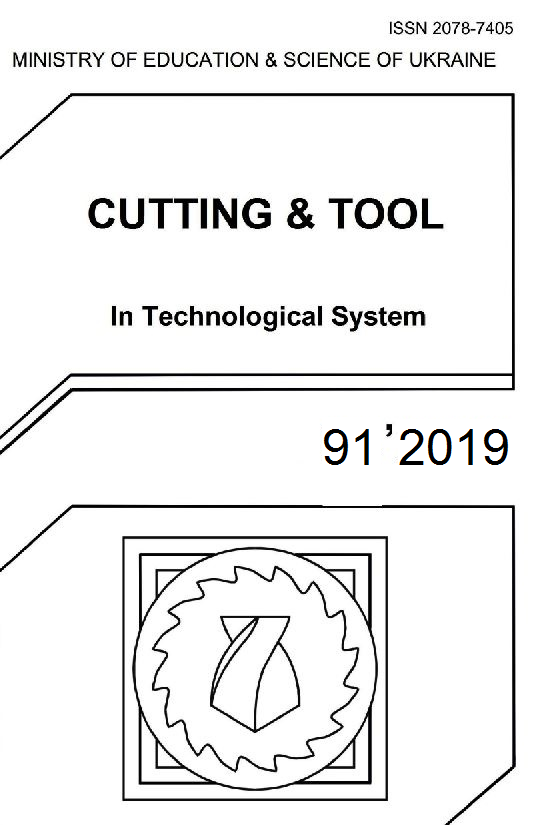DEVELOPMENT OF THE MATHEMATICAL MODEL SMOOTHING WHILE USING FEA
DOI:
https://doi.org/10.20998/2078-7405.2019.91.06Keywords:
Slide diamond burnishing, FEM, four-factor experiment, mathematical process model, second-degree regression equation, stresses.Abstract
The following paper provides insight into developing of a mathematical model of burnishing process. Burnishing is an efficient manufacturing process for surface finishing of metal products. Using this manufacturing process, it is possible to achieve an excellent surface finish, improve surface properties and quality of the product. The mathematical process model was developed using FEA. In the development process was used a specialized software “AdvantEdge” by Third Wave Systems. Usage of FEM-Simulations makes it possible to reduce the number of real-life experiments by developing of the model and the hard-to-measure process characteristics can be defined. The developed mathematical model of the burnishing process makes the process optimization much more efficient and reduces the number of real-life experiments. Thus, this optimization process is more economically attractive and environmental friendly.References
K. Röttger, Walzen hartgedrehter Oberflächen, Shaker Verlag, Aachen, 2003.
L.N. Lopez de Lacalle, A. Lamikiz, J. Munoa, J.A. Sanchez, Quality improvement of ball-end milled sculptured surfaces by ball burnishing, International Journal Machine Tools & Manufacture 45 (15) (2005) 1659–1668, https://doi.org/10.1016/j.ijmachtools.2005.03.007.
A. Rodríguez, L.N. López de Lacalle, A. Celaya, A. Lamikiz, J. Albizuri, Surface improvement of shafts by the deep ball- burnishing technique, Surface & Coating Technology 206 (11–12) (2012) 2817–2824, https://doi.org/10.1016/j.surfcoat.2011.11.045.
F.J. Shiou, C.H. Chen, Freeform surface finish of plastic injection mold by using ball-burnishing prozess, International Journal Advanced Manufacturing Technology 140 (1–3) (2003) 248–254, https://doi.org/10.1016/S0924-0136(03)00750-7.
H. Luo, J. Liu, L. Wang, Q. Zhong, Investigation of the burnishing process with PCD tool on non-ferrous metals, Int. J. Adv. Manuf. Technol. 25 (2005) 454–459, https://doi.org/10.1007/s00170-003-1959-5.
N.H. Loh, S.C. Tam, S. Miyazawa, Statistical analyses of the effects of ball burnishing parameters on surface hardness, Wear 129 (2) (1989) 235–243, https://doi.org/10.1016/0043-1648(89)90261-5.
W. Zhuang, B. Wicks, Numerical analysis of residual stresses induced by low plasticity burnishing. Key Eng. Mater. 23 (3) (2002) 809–814, http://refhub.elsevier.com/S0924-0136(14)00278-7/sbref0130.
Torbilo V.M. Almaznoe vyiglazhivanie. – M.: Mashinostroenie, 1972.-104 p.
M. Korzynski, A model of smoothing slide ball-burnishing and an analysis of the parameter interaction, J. Mat. Process. Tech. 209 (1) (2009) 625–633, https://doi.org/10.1016/j.jmatprotec.2008.02.037.
F.L. Li, W. Xia, Z.Y. Zhou, J. Zhao, Z.Q. Tang, Analytical prediction and experimental verification of surface roughness during the burnishing process, Int. J. Mach. Tool. Manuf., 62 (2012) 67-75, https://doi.org/10.1016/j.ijmachtools.2012.06.001.
L. Hiegemann, C. Weddeling, N.B. Khalifa, A.E. Tekkaya, Analytical prediction of roughness after ball burnishing of thermally coated surfaces, Procedia Eng., 81 (2014), 1921-1926, https://doi.org/10.1016/j.proeng.2014.10.257.
L. Hiegemann, C. Weddeling, N.B. Khalifa, A.E. Tekkaya, Prediction of roughness after ball burnishing of thermally coated surfaces, J. Mat. Process. Tech., 217 (2015), 193-201, https://doi.org/10.1016/j.jmatprotec.2014.11.008.
L. Hiegemann, C. Weddeling, A.E. Tekkaya, Analytical contact pressure model for predicting roughness of ball burnished surfaces, J. Mat. Process. Tech., 232 (2016), 63-77, https://doi.org/10.1016/j.jmatprotec.2016.01.024.
A. Sagbas, Analysis and optimization of surface roughness in the ball burnishing process using response surface methodology and desirabilty function, Adv. Eng. Software, 42 (11) (2011), 992-998, https://doi.org/10.1016/j.advengsoft.2011.05.021.
M.M. El-Khabeery, M.H. El-Axir, Experimental techniques for studying the effects of milling roller-burnishing parameters on surface integrity, Int. J. Mach. Tools and Manufacture, 41 (12) (2001), 1705-1719, https://doi.org/10.1016/S0890-6955(01)00036-0.
Zaytsev B.G., Shevchenko A.S. Spravochnik molodogo tokarya / B.G. Zaytsev, A.S. Shevchenko. – M.: Vyisshaya shkola, 1979. – 367 p.
Klimenko S.A. Finishnaya obrabotka poverhnostey pri proizvodstve detaley / S.A. Klimenko; pod obsch. red. S.A. Chizhika i M.L. Heyfetsa. – Minsk: Belaruskaya nauka, 2017. – 376 p.
W. Zhuang, B. Wicks, Numerical analysis of residual stresses induced by low plasticity burnishing. Key Eng. Mater. 23 (3) (2002) 809–814, http://refhub.elsevier.com/S0924-0136(14)00278-7/sbref0130.
Downloads
Published
Issue
Section
License
Copyright Notice
Authors who publish with this Collection agree to the following terms:
1. Authors retain copyright and grant the Collection right of first publication with the work simultaneously licensed under a Creative Commons Attribution License that allows others to share the work with an acknowledgement of the work's authorship and initial publication in this Collection.
2. Authors are able to enter into separate, additional contractual arrangements for the non-exclusive distribution of the Collection's published version of the work (e.g., post it to an institutional repository or publish it in a book), with an acknowledgement of its initial publication in this Collection.
3. Authors are permitted and encouraged to post their work online (e.g., in institutional repositories or on their website) prior to and during the submission process, as it can lead to productive exchanges, as well as earlier and greater citation of published work.

